There was a break in the constant greyness that has blanketed the skies for most of the week, It only lasted an hour but I made the most of it.
First off, I setup the 15x70's on my camera tripod, and headed out to try and find this elusive comet that has been around for the past couple of weeks, Comet Lulin. I tried on Saturday, but failed. Anyway, after checking it's position on Heavens Above, I pointed the bins to roughly the right place, and with only a minor sweep, there it was. Excellent and one of those Wow moments.
With my excitement levels rising, I dashed inside, grabbed the HEQ5, carted it out. Plonked it down roughly pointing north, leveled and polar aligned it. I was setup in about 5 minutes, which I reckon is pretty good going, considering it's only my third attempt.
So all setup, mount running, I slewed around, using the clutches, to the right point in the sky, then realised, I hadn't checked my focus... Ah well, Saturn is nearby, thinks I. The ringed one, is a great object for focusing on, as the ring pops out cleanly when focused. So I slewed back, attmpted to line up on what I thought was the star near Lulin I'd been looking at in the bins, and fired a test shot. Hmm, no comet. I used the motor controls to sweep about a bit, and try and find it, but this wasn't helping either. Then it occured to me. The RDF is great, but only for general locating. Given I have my Konus piggybacked (needed for weight balancing) I wondered if it would make a good finder scope. So I grabbed the 17mm Hyperion, popped it in, quickly found the comet and centered it (quite some finder scope a 24x80). Tried a test shot. Hmm, not in the image. I adjusted around a little till I found it, and started shooting 2.5 minute frames. The 3 minute frame was showing signs of trailing.
I set the timer remote to capture 11x2.5 minute subs, and went back to the bins for a longer look. I thought I could clearly see, after studying the comet for a while, that it was changing position relative to the background stars. After watching for a while, I went and had a look at Saturn. Not an easy target at this low power, but the rings could just be made out. I kept glancing round, as a cloud bank was moving in from the north, and I have to say I was very lucky, as the first fingers of it, passed just under Leo and the area I was imaging in. However, it wasn't enough, and I had to stop after only 7 subs.
I then spent a few minutes, adjusting the Konus position, with some card wrapped in duck tape, propped between the OTA and tube rings, to get the collimation a little more accurate, I doubt very much this will be an issue for guiding, as long as I can find a star in the FOV, but as a finder scope, it's more useful, as I can use a diagonal and a decent ep, instead of the camera viewfinder, thus it's much more comfortable (wish I'd thought of that a couple of weeks ago, but that's another story).
Anyway, I cleared up and packed away. Here's a single 2.5 minute sub
The results of the Stack. DSS has a comet mode which I used. It appears to have done a double stack, one for the comet and one for the background stars. Anyway, 7x2.5 minutes, 32.5 minutes @ISO800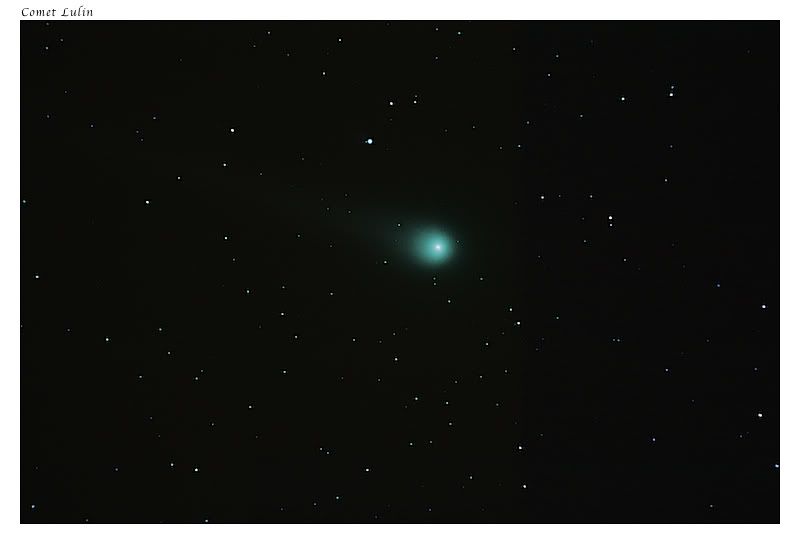
And an animation of the 7 frames, which clearly shows the movement of the comet relative to the background stars.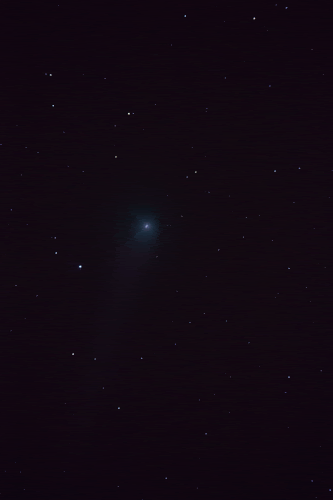
I'm really glad the weather broke and allowed me the opportunity to see and image Lulin, I had feared I was going to miss it altogether.
Friday, 27 February 2009
I looked, I saw, I shot
Monday, 23 February 2009
M42, M43, The Running Man and some Bino viewing
Saturday night was clear, after a day of clear skies, this was most unusual, and after the clear day I was expecting heavy clouds. Still, I wasn't going to look a gift horse in the mouth. I already knew what I was going to do, and at 1830, darkness setting in nicely, I carted the gear outside and setup. Early I know, but I wanted to make the most of it.
Plonked down the mount, powered up, went to polar align and realised as I was looking through the polarscope, I'd forgotten to set the axis for the correct date and time. So I did this (little did I know I got that simple task wrong, but more on that later). Polar aligned, swung around to Rigel, adjusted my RDF (I must have knocked it at some point) and focused the camera. I got focus, checked it with a test sub, then locked the drawtube, only to find, that tightening the focus lock, was enough to shift out focus... grr... Ok, loosened it a little and refocused. All set. I adjusted manually to the M42 region and shifted around with the tracking motors till I got the nebula just where I wanted it, taking framing shots as I went. I tested for longer exposures, but 2 minutes was all I could manage, I'd obviously messed something up, but couldn't see what. Ah well, 2 minutes it would be. I pushed the ISO to 1600 and set the camera gathering 2 minute subs, or so I'd thought. I'd set the camera to 30s, for my test shots, and forgot to set it back to bulb mode. I check it regularly, and noticed after only 17x30second subs, so I didn't lose too much time, and besides that would help with the core. I adjusted the camera, set the timer remote for 90 subs and set it all running.
My youngest wondered what I was up to, so we trotted out and I showed him. He was very surprised what I was getting when he looked at the preview screen on the camera. He wanted to have a bit more of a look around, so I grabbed the 15x70's popped them on a tripod and showed him some sights.
First off, M45, such a lovely sight in bins. I had him look both around the bins, and then through the bins, and he was astonished at the number of points of light in the darkness. So we went on a little tour of some of the grander sights, better suited for a 7 year old. M42, and he could see the glow easily enough. He wanted to look at that orange dot, so I pointed the bins to Betelguese for him, not really a lot different. I pointed out Orion and Gemini and the Big Dipper, nothing wrong with learning the constellations, should be easy for him. He asked me what that "twinkling bright star" was, a bit below Orion, ah said I, that's Sirius, the Dog Star, brightest star in our night sky. We had a quick discussion then about the distances involved, how Sirius is pretty close, the Pleiades, about 450ly's away, really meant we were looking back in time 450 years. He thought this was pretty cool. When I told him, how far away M31 was, he wanted to see that too. And was amazed we could see something so far away that the light we were looking at it left it 2.2 million years ago.
Then back closer to home, and the Beehive cluster (although, apparently it's the Beehive galaxy... a reference to Super Mario Galaxy, but quite sweet). And again, he was astonished by how many stars there are that you can't see without bins. Then onto M38, and more importantly the Smiley Face. I thought he'd like that one, and he did. Then a quick turnaround, back to the Big Dipper for a look at the Horse and Rider (he passed his Roman army eyesight test) and mummy came out to check. So we showed her the Pleiades and I think she was quite impressed, and we went inside. Where we spent a little while looking at the planisphere and explaining to him how to use it.
Time passes ....
I keep popping out and checking up on what's going on, all looking good. What I didn't notice, 2 hours into the run, was that the objective was dewing up, which I'm a bit miffed about as I lost an hours worth of data because of it (I tried to include them in the stack, but it made the result look unfocused). I noticed the mount power light was flashing, so I plugged the powertank into the mains (that wasn't one of my best conceived plans) putting the plug and power supply into a plastic box, in a bin bag.
The three hours up, I went back out to find, the powertank was no longer charging, nor doing anything for that matter, the mount had stopped moving altogether, the last three subs were a blurred mess. It turns out the power supply to the powertank had fried in the process of trying to keep things running. Damn. Thankfully I have another one I can use and it looks like the powertank has charged up again. I need to think my power supply out more carefully. I'm thinking, either a mains supply in a plastic tooldbox, or a leisure battery in the same housing.
Anyway, I downloaded the subs, stacked them, threw away that result as it looked out of focus, restacked without the subs with the dewed objective, threw the data from last week into the mix so I had 17x2mins @ISO800 (from last week), 17x30s @ISO1600 and 50x120s @ISO1600. I used 11 darks, 17 flats, and 15 dark flats, stacked in DSS with a Log(SQRT) stretch and tweaked in PS.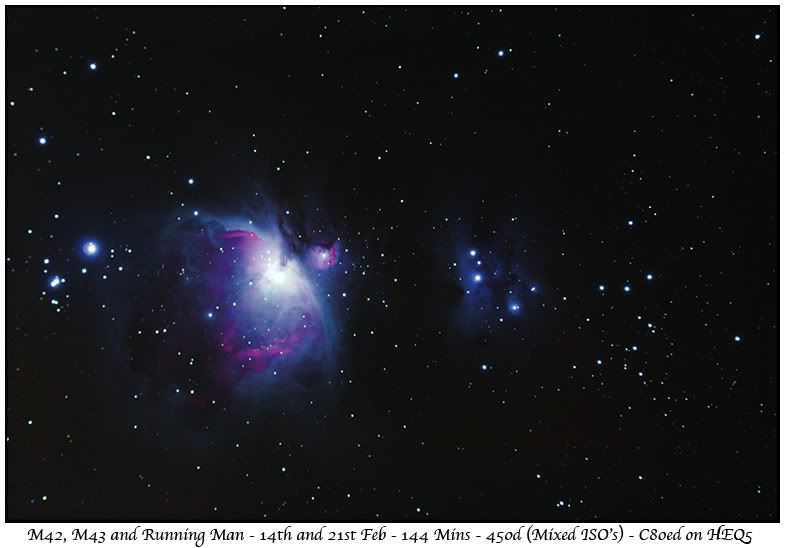
I'm done with this target for now. I don't think I'll be able to do much more with it, until I'm guiding or using a modded camera or both. I also managed to figure out the likely cause of the reduced sub length from last week. I messed up the align a little. I'd used the wrong time and was an hour out. Ah well. I'm really pleased with the end result though.
Sunday, 15 February 2009
A night under the stars
Friday night came around and it was clear. Not just clear, but really clear. Excellent. So after I'd done all that needed to be done, I headed out into the garden. I put the HEQ5 down, so the N leg was pointing roughly at North, powered up the mount (hoping that my power pack would last) and got on with polar aligning. A quick swing of the axis to set the current date and time, some minor adjustments on the Altitude and Azimuth bolts and I was there. I powered down, popped the camera on the scope, used the axis clutches to swing around to Sirius, powered up and used Sirius for focusing. The usual 10x liveview and adjust. Then to see what sort of exposure length I could do. Well first off I took a single 2 minute shot of Sirius
With that done, I used the clutches again to swing around to Orion and M42. I used the opportunity to grab a bunch of 2 minute subs of the area.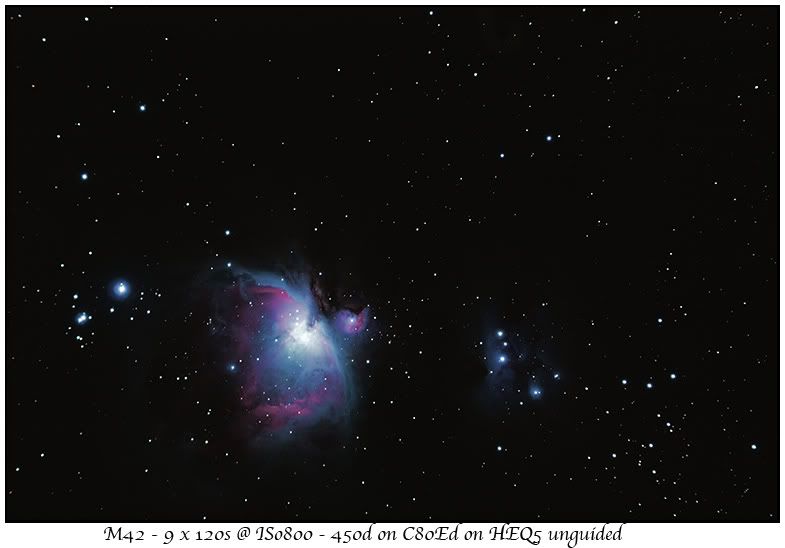
I'm really pleased with how this has come out, but it really needs more time on it, and darks (I forgot to take them).
Whilst I was capturing this data, I used my 15x70's and had a wander around, reacquainting myself with some friends from last year. I started with M35, then moved almost straight up, through M36, M37 and onto M38. In the FOV of the bins, M38, Mr Smiley, and I think the little fish were all visible. A very nice sight. Then, of course, how could I miss the sisters, onto M45 for a view of the gems on velvet, a lovely cluster, that I come back to as often as I can, and one I intend getting the HEQ5 and C80ED on at some point soon.
Then, swinging down and across, the faint glow in the middle of cancer that marks out the beehive caught my eye, so I had a good look at that too. Then back to Sirius and the clusters in that location. Spotting first off M41, then up and across to M46 and M47.
Then, the M42 data captured, I moved on to have a bash at M44. I swung around, tried to align as best as I could (not easy, as I had to half lie on the floor and sort of get my head between the tripod and the camera... Hmm... gonna have to do something about that. Anyway. I captured a couple of subs, and checked them. The cluster is too big for the C80ED to frame and some stars sit outside the frame, shame.
So I decided, as I'd seen it in the bins, that I'd have a crack at M41, here's the result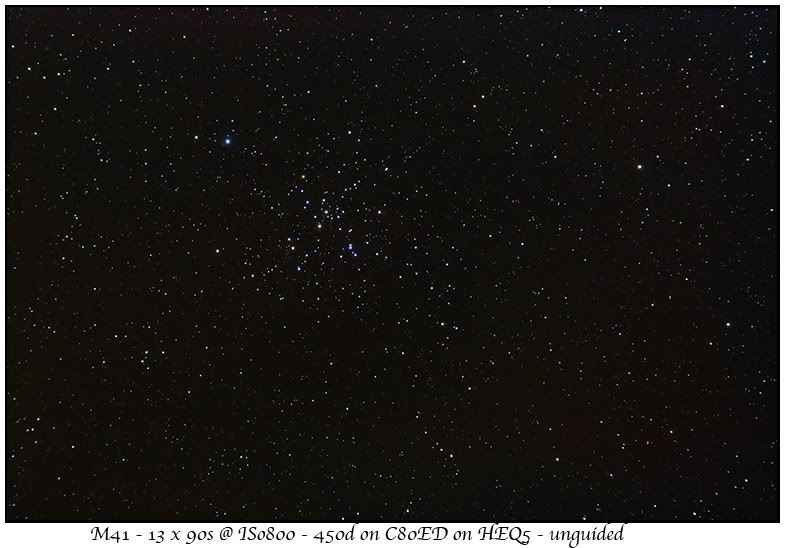
I really like the results here, the colours in particular.
Whilst this data was being captured, I had some more time with the Bins, on up to Mirfak and it's association, around a little more to look at the Double Cluster. Not easy now as it's playing peekaboo in the trees...
I then noticed that the Dipper had swung around and up, and had a look around for Mel 111, it took me a few minutes, but again found it and had a good look here. Then, with Leo rising above the rooflines, and a bright dot somewhat below, I swung the bins onto it, and there was Saturn. Always an impressive sight, but tricky to see in handheld 15x70's.
I then moved back to Orion and had a good look at him. M42 being the obvious one, and a patch of grey, sort of birdy shaped mistiness. Up to the belt and I think it's a Struve cluster around the centre star, and the same around Orion's head (although I can't remember the names or the numbers).
I noticed as I finished capturing the data for M41 that the objective was misting up, so I grabbed the OH's hair dryer and gave it a very gently fanning to clear the mist, adjusted the mount to point to Alnitak, and tried to see how far I could push. At 4 minutes, trailing was beginning to creep in, so that was a bit far, I dropped back to 3 minutes (although I could probably have got away with 3.5 mins), pushed the ISO up to 1600, and set about trying to capture the horse head and flame. Having set the timer remote, I went in for a cuppa and to warm up leaving the gear running. This really needs an entire session devoted to it, with an unmodded camera it takes some serious time to capture, and even then it's very very faint, but it's there.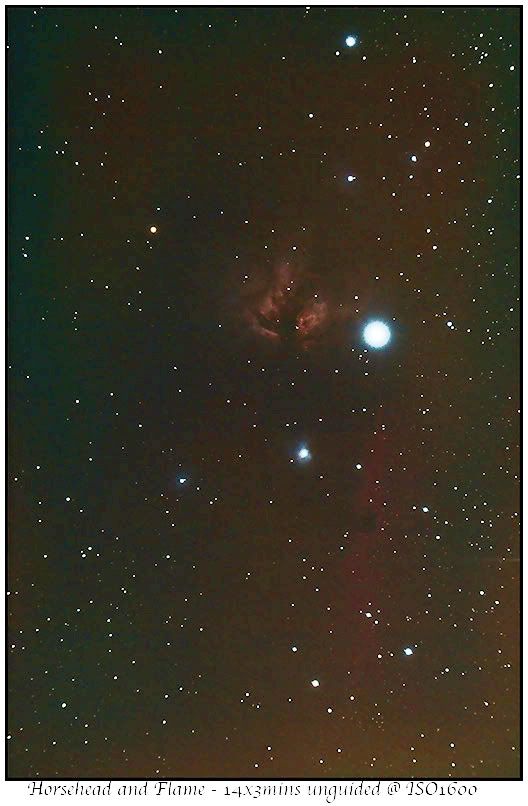
I'm really pleased with this session, it's proved the mount and scope are very capable and opens up huge amounts of possibilities.
Tuesday, 10 February 2009
Lunar Panoramics and testing the mount
Finally, after nearly 2 weeks, I got the HEQ5 out for a session. Plonked it down, I was able to carry the entire thing all bolted together which is something, with the N leg in about the right direction, plugged in, swung the scopes to open the polar scope hole, swinging the dec (??) axis to set the current date and time on the circles, and started to polar align (I'd been dreading this bit, as I've got how important this bit is).
Anyway, I was having some difficulty polar aligning, I couldn't see Polaris, so I double checked and whilst I thought I'd set the altitude to 51degrees, I was sadly mistaken, quickly rectified that, and Polaris slipped into the FOV. Some adjustments on the bolts, Polaris slid into the correct point on the reticule. I have to say that the red illumination made this very easy.
The moon was up, so I swung around to that. Shifting each axis and getting closer with each move. It took a few moments, as the movements were peculiar, but I don't think it's going to take long to get used to this mode of movement.
I had a quick look with the 5mm Hyperion and Ultima barlow and I have to say, the view, once focused was superb. I did notice that I didn't have to wait anywhere near as long for the vibrations to settle, that's much better. Then I had a few goes at imaging the moon, I used the 2x Ultima Barlow (now how did that get bought, must have fallen in the basket when I ordered the mount) and as this gives about 2.5x with the 450d, I shot two frames and made a vertical panoramic out of it.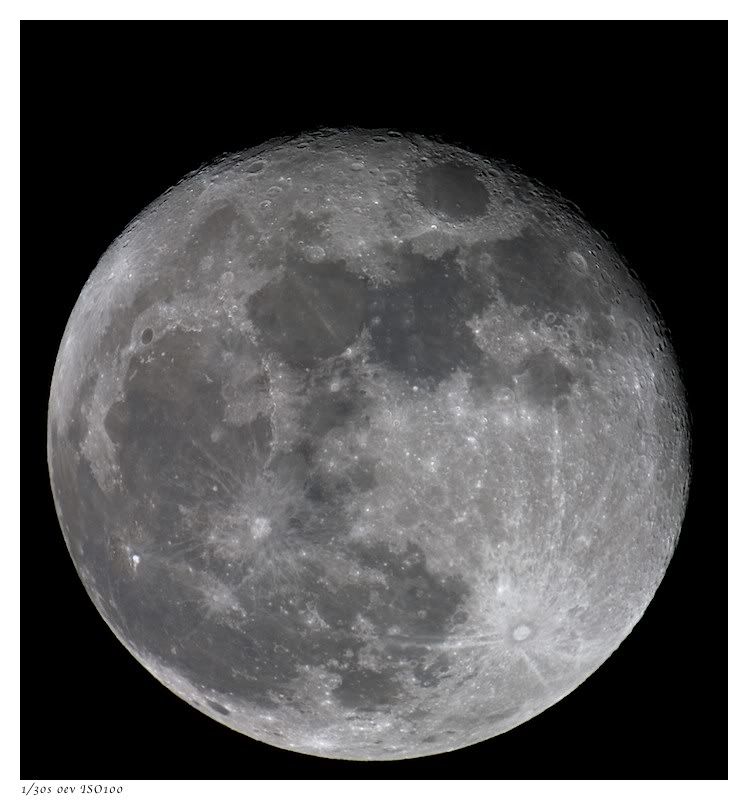
Then as there was some colour data in there, pushed up the saturation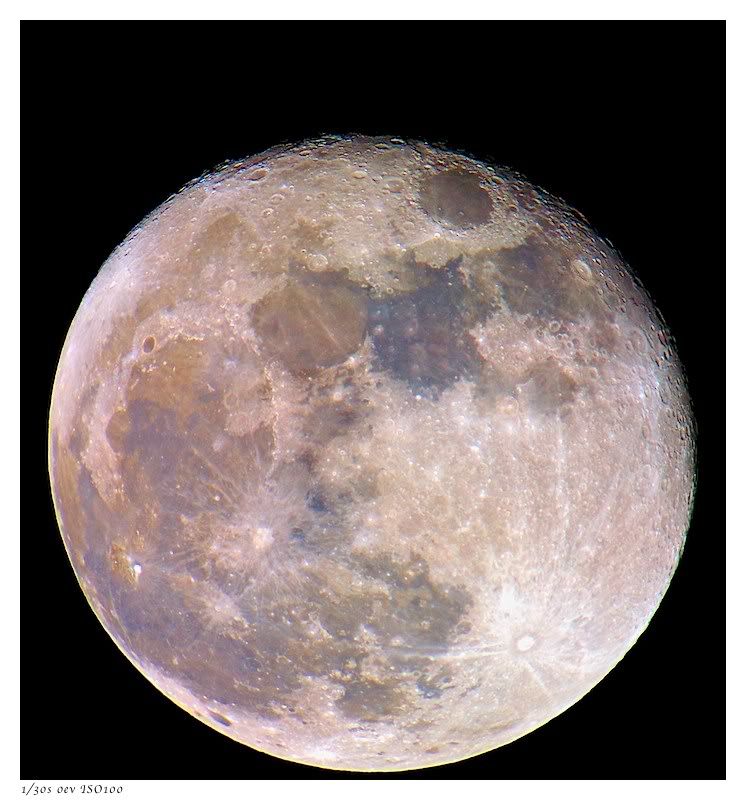
I then swapped to the SPC900 (with the contrast booster attached) for some webcam attempts around Langrenus
With the Ultima, about 400 of 600 frames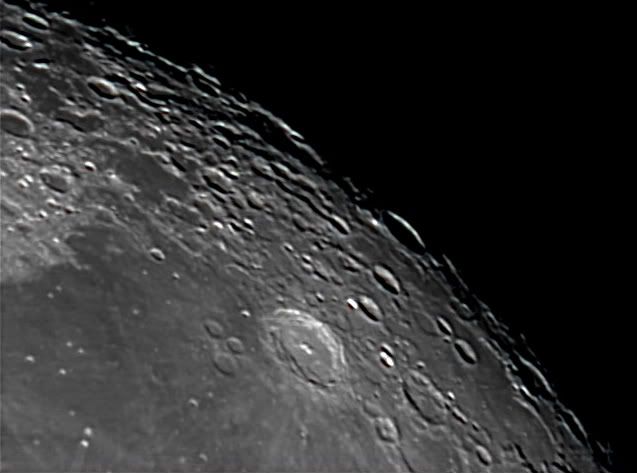
And Colourised a little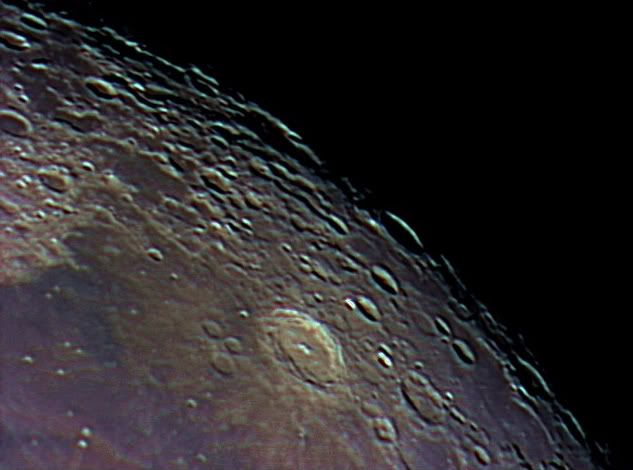
As the seeing was so rough, I took out the barlow and just used the webcam, about 1200 of 1800 frames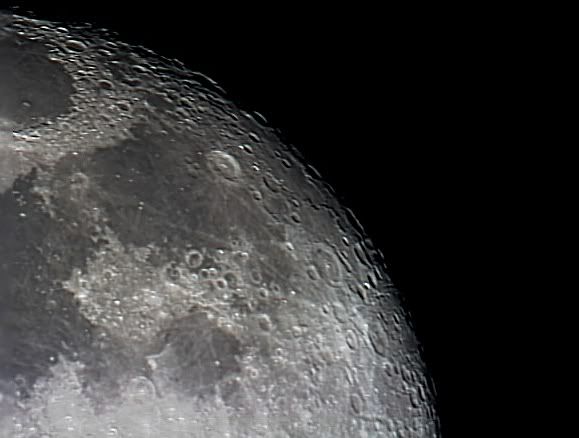
Then as I was swinging around to look for Saturn, the power pack gave up and the mount wouldn't track or slew anymore. A quick check of the gauge and it showed as flat as a pancake. Serve me right for not charging it back up after playing with the movement controls a few times.
I have to say I needed that. The mount is far easier to setup and align than I thought it would be, and the same is true for the movement controls. Hopefully I'll get a few clear nights so I can test it out further.
Monday, 9 February 2009
The moon
Due to illness and the weather, I've not been out to look at anything for a while, I was able to get just a single shot of the moon, through the C80ED with a 2xTC






